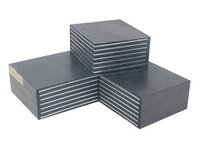Hello everyone,
I need to model an elastomeric laminated bearing in abaqus. I have the sufficient material properties. The steel laminates in the bearing are thin (~0.1"), and the bearing has a thin cover on all sides (0.2").
I have tried modeling it using 3D deformable elements, but because of this:
1. the laminate elements are too small in thickness and it decreases my stable time increment,
2. the cover elements are too small in size due to partitioning and meshing the 3D rubber part
I want to switch to modeling the laminates as 3D shells, and am willing to keep the covers. Any tips on how I can go about modeling it, and making the tie interaction between the 3D solid and the laminate shell (shell would be fully inside the rubber), and I get a better element size?
I need to model an elastomeric laminated bearing in abaqus. I have the sufficient material properties. The steel laminates in the bearing are thin (~0.1"), and the bearing has a thin cover on all sides (0.2").
I have tried modeling it using 3D deformable elements, but because of this:
1. the laminate elements are too small in thickness and it decreases my stable time increment,
2. the cover elements are too small in size due to partitioning and meshing the 3D rubber part
I want to switch to modeling the laminates as 3D shells, and am willing to keep the covers. Any tips on how I can go about modeling it, and making the tie interaction between the 3D solid and the laminate shell (shell would be fully inside the rubber), and I get a better element size?

